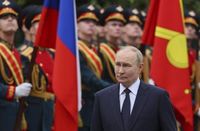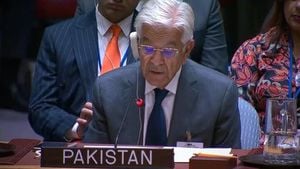The debate over how NATO should respond to Russian aerial incursions into alliance airspace has reached a fever pitch, with leaders and experts weighing in after a series of high-profile violations across Europe. In recent weeks, Russian drones and fighter jets have repeatedly crossed into the airspace of NATO members, prompting calls for tougher action—and igniting a fierce war of words between Moscow and the West.
Ukrainian President Volodymyr Zelenskyy, speaking with Axios in New York on September 24, 2025, didn’t mince words. He argued that NATO’s response to Russian airspace violations has been “very” weak, which, in his view, has only emboldened Moscow. “They should have shot down everything,” Zelenskyy said, referring to Russian drones and planes that have entered the skies over Poland, Denmark, Norway, and Romania. “If someone on your land kills your people, you must respond to that person. If planes are in your zone, you must block them.” According to UNN, Zelenskyy’s frustration is rooted in a string of incidents that he believes have not been met with the necessary resolve.
His remarks come on the heels of a dramatic escalation: three Russian MiG-31 fighter jets violated Estonian airspace for 12 minutes, triggering a swift diplomatic protest from Tallinn. The Estonian Ministry of Foreign Affairs summoned Russia’s temporary chargé d’affaires, delivering a formal note of protest. Estonia’s foreign minister warned that such incursions bring the Baltic states “closer to armed conflict than ever in recent years.” (UNN)
Former U.S. President Donald Trump, never one to shy away from controversy, chimed in during a meeting with Zelenskyy on the sidelines of the UN General Assembly. When asked whether NATO members should shoot down Russian planes violating their airspace, Trump replied unequivocally: “Yes, I do.” (Flash Brief) He later added that any direct U.S. support for such actions would depend “on the circumstances.” Trump’s stance represents a notable shift in tone, signaling a willingness to escalate if Moscow continues to test NATO’s resolve.
Trump’s comments found support from NATO Secretary-General Mark Rutte, who told Fox News, “I totally agree here with President Trump.” Rutte added that NATO “will also do more, and if necessary, the ultimate to protect our people.” In a further show of determination, Rutte announced the launch of Operation Eastern Sentry on September 12, 2025. The operation aims to bolster air defenses along NATO’s eastern flank after repeated drone incursions over Poland and Romania forced NATO jets to scramble. (Flash Brief)
But the tough talk from Washington and Brussels has drawn a sharp rebuke from Moscow. Kremlin spokesman Dmitry Peskov, speaking to Russian state TV on September 26, denounced the calls to shoot down Russian aircraft as “reckless, irresponsible and carry dangerous consequences.” He accused Western leaders of escalating tensions and dismissed Estonia’s claims about the MiG-31 incident, saying Tallinn had provided “no evidence” and was engaging in “yet another significant escalation of tensions near our border.” (Agence France-Presse)
Russia’s response is part of a broader pattern of defiance. Peskov, sidestepping direct reference to Trump, cast the calls for shooting down Russian planes as coming from Europe. He also pushed back against Trump’s characterization of Russia as a “paper tiger.” “Russia is in no way a tiger. Still, Russia is more compared with a bear. There are no paper bears,” Peskov retorted, as reported by Flash Brief.
The aerial chess match is not limited to fighter jets. Denmark was forced to close several airports on September 25 after unidentified drones crossed its airspace—a move Danish Defense Minister Troels Lund Poulsen described as a “systematic operation by a professional actor.” Authorities have not directly linked the drones to Russia, but the timing has raised eyebrows. With an EU summit scheduled for October 1-2 in Copenhagen, Denmark quickly accepted Sweden’s offer of military anti-drone technology. Swedish Prime Minister Ulf Kristersson said, “We have seen extensive drone activity in different countries the past few days. Very unwelcome drones.” (Agence France-Presse)
Sweden, for its part, has invested heavily in air defense systems, ordering more than 10 billion kronor (about $1.06 billion) worth of technology capable of countering both drones and planes in recent months. Swedish Defence Minister Pal Jonson told AFP that new anti-drone capabilities are part of a broader effort to strengthen the region’s defenses.
These incidents are not isolated. Earlier in September, NATO scrambled jets after around 20 Russian drones flew through Polish airspace, downing at least three. The pattern of violations—across Poland, Romania, Estonia, and Denmark—has left many European capitals on edge, fearing that Moscow is probing for weaknesses or testing NATO’s willingness to respond.
The situation has also reignited debate within NATO about the best way to deter further aggression. Some alliance members, according to Zelenskyy, remain hesitant to shoot down Russian aircraft, fearing Moscow’s unpredictable response. “I know that some of them are not afraid, but mostly countries are afraid. They are afraid because Russia is crazy,” Zelenskyy said in his interview with Axios.
The Foundation for Defense of Democracies (FDD) experts have weighed in, urging a more robust approach. “President Trump has made it clear that NATO allies must be ready to defend their airspace with force,” said Peter Doran, an adjunct senior fellow at FDD. “He has unequivocally stated that any Russian aircraft violating allied borders should be shot down. This is a critical step in a strategy that affirms that ‘Ukraine can win’ and an unmistakable declaration that allies should not be afraid to defend themselves.”
Other analysts point to a possible link between the uptick in Russian provocations and reductions in U.S. security assistance to NATO’s eastern flank. Bradley Bowman, FDD’s Senior Director of Military and Political Power, commented, “Putin clearly believes he can continue his war of conquest in Ukraine and violations of NATO airspace without consequences. It is likely not a coincidence that the successive violations… came after Pentagon officials reportedly notified European allies that the United States would cut key security assistance funding for deterrence on NATO’s eastern flank with Russia.”
Despite the heated rhetoric, a full-scale military confrontation remains a prospect that all sides seem eager to avoid. Zelenskyy himself has insisted that Ukraine is not demanding specific weapons from NATO or seeking to escalate the war, but he maintains that “strong responses are needed.” The debate now centers on what form those responses should take—and whether NATO’s resolve will be enough to deter further Russian provocations.
As European leaders prepare for the upcoming EU summit in Copenhagen under the shadow of mysterious drones and jittery airspace, the question of how to respond to Russia’s aerial incursions has never felt more urgent—or more fraught with risk. What happens next could set the tone for East-West relations in the months to come.





